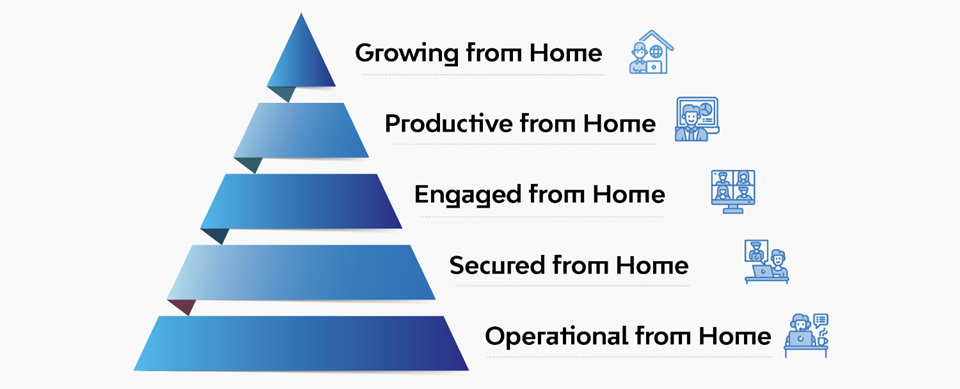xFH – LTI Design for Thriving in the WFH Future

Nachiket Deshpande
Chief Operating Officer and Executive Board Member, LTI
Nachiket’s vast global experience spans across tech consulting, products, and platforms, as well as driving large-scale skills transformation.

Siddharth Bohra
Chief Business Officer – Tech, Media, Consumer & Life Sciences and Head – Digital &
Analytics, LTI
Siddharth has an impressive record of harnessing digital technologies and innovative business strategies to create a fertile ecosystem for fast-paced growth.
From just “Work from Home” (WFH) to “Everything from Home” (xFH)
Working in an office has been prevalent since Roman times. ‘Officium’ was at the heart of every town. Since the 1700s, we have seen grand buildings built to house office workers and the evolution of different types of office design – Open plan, Bürolandschaft, Action office, Cube farm, Hotdesking, shared workspaces, and majestic creations like the Googleplex and the Apple Infinite Loop. Companies have connected their global office locations for seamless working across the world.
In the Pre COVID-19 world, the thinking and policies on remote working was company specific. There were no widely accepted models for remote working, and this was not an area of investment either. Focus was rather on connecting office locations across the world. The world over, we’re facing an unprecedented crisis. Who could have said their business continuity plans accounted for a scenario in which every country would be impacted by such disruptions to both demand and supply?
Among our business contacts, everyone keeps talking to us about… well, Darwin! Only they’re not talking about opposable thumbs or herd resistance to pathogens. No, they’re talking about who’s going to survive the current business landscape-the new normal-and who will go by the wayside.
How we are responding to something unseen in history
The entire world is literally locked down and in the truest sense of the word, global WFH is now a reality. The sheer scale of people working, communicating, and collaborating across vast physical distances is akin to no other time in history.
And yet, this storm will pass. However, most leaders agree that it’s quite nearsighted to assume that things will ever go back to the way they were. Many short-term emergency measures will become permanent fixtures. After all, that’s the nature of emergencies, isn’t it? They fast-forward historical processes for people, governments, and businesses.
These changes will test the operating model for all businesses, including our own at LTI.
In this blog, we are sharing LTI’s approach to our journey from simply operational from home to growing from home- we call it Everything from Home, or xFH.

Returning to Darwin, we look at LTI as a living organism: to survive, it must transform its operating model to emerge stronger in this totally new normal. But how? What will it take for us to scale WFH infrastructure across all business units and locations, up and down the chain of command, while maintaining optimal security and productivity? And maybe create even better outcomes than established models. At LTI, we broke down WFH in five layers, each with a specific set of interventions, tools, governance & outcomes – these layers traverse foundational needs to team & individual needs. Let’s dig in.
Layer 1: Operational from Home (OFH)
What has become our new remote-design-model at LTI began merely as a response to the emergency situation facing our organization: COVID-19. Our task was to quickly, efficiently, and securely enable thousands of distributed employees to be operational from home.
The OFH layer encompasses all that goes into giving each employee the devices and equipment they need to work from home in a safe, healthy, and productive way. Of course, the needs of one employee might differ from another: OFH needs of North America-based HR manager are different than that of a sales engineer in India. These variations can create a rather complex OFH layer when considered at scale.
Enabling employees at the OFH layer will ask questions of both your IT infrastructure, as well as your business continuity planning (BCP). We’ve had to take a close look at both given these new circumstances.
Layer 2: Secured from Home (SFH)
When we work at office, organizations are tasked with providing reliable and secure connectivity, so we have access to resources, colleagues, and customers. Even in advanced countries, and large organizations known for dependable IT infrastructure, moving to a fully distributed workforce can create bandwidth issues that disrupt business and degrade customer experience.
At LTI, ensuring people have the right connectivity is hygiene. But this has gone beyond providing secure infrastructure for business email, intra-corporate chat, video conferencing capabilities, and WiFi support for connected devices. We’ve had to assess our broader security posture to make sure that the connectivity solution we first implemented in response to COVID-19 is hardened to ensure enterprise security in the long-term “new normal”—to ensure that security awareness and acceptable use policy is a well-established baseline for all our WFH employees.
Layer 3: Engaged from Home (EFH)
If engagement was a challenge facing distributed workforces before, now the challenge is even more acute. Being away from colleagues and friends, teammates, and a familiar work environment tends to engender a lack of engagement that’s costly to both morale and productivity. There’s a certain immediacy to face-to-face discussions, lunch conversations, or impromptu business chats, the lack of which can require a significant adjustment.
How do we design toward the active engagement of a remote workforce, one that’s sitting in thousands of different locations at once—people who haven’t met with each other in person for a month or longer?
At LTI, this is what we focused on the most right after initial enablement. Along with technology enablers like Microsoft Teams and Workplace, it needed us to adopt new practices on how we interact with our teams and colleagues. We were amazed with the innovative ideas different teams adopted – daily standups, virtual coffee or drink sessions, ‘We care’ moments, 5X5X5 initiative – connecting with 5 new team members at 5 pm, 5 days a week. These have now become integral part of LTI’s Ways of Working.
Layer 4: Productive from Home (PFH)
Think about the companies out there that have to keep critical systems running in order to ship life-saving drugs to hospitals and communities in need. Critical banking and financial systems across the world are needed to keep economies ticking. Some of our clients were in the middle of critical regulatory programs with significant financial liability if we missed key milestone.
The point is, having the preceding three layers of xFH in place still doesn’t guarantee the productivity of your remote workforce, especially when everyone is under duress. Are your teams still meeting contractual obligations, meeting and exceeding the expectation of your clients? Is the quality of service and business deliverables where it needs to be?
LTI teams kept majority of our contractual commitments and they kept important go-live dates on track and executed flawlessly, working entirely remotely. In the past month, we have numerous examples where we have witnessed higher productivity working from home.
We have not only managed this in our ongoing projects, but our teams have also evolved our platforms and methodologies to carry out upstream processes like solutioning, requirements workshops, service transitions completely remotely, with very little loss in productivity.
Interventions in the layer of xFH stack gives us confidence that we can not only adapt to this new normal but can actually operate at different level of enterprise efficiency.
Layer 5: Growing from Home (GFH)
Finally, it’s at the Growing from home (GFH) layer that our teams find the opportunities for professional development and, where appropriate, turn those opportunities into growth for the organization. This layer is about personal growth, about finding ways to continue the journey of professional transformation. At LTI, sales, marketing, support, services, and other teams are all engaged at the GFH layer.
xFH – A Comprehensive framework to make WFH effective
For the foreseeable future, WFH is the new global norm. As with any competitive landscape, some organizations will find ways to adapt and thrive under a fully distributed model, while others will unfortunately flounder.
That’s what the xFH model is all about: helping organizations make sense of their own WFH model, understand the layers that comprise it, then drive meaningful and impactful interventions at each of those layers—and across all layers—to ensure optimal business outcomes.
It seems we are evolved an entire ‘generation’ in last 6 weeks. That means professionally too. Due to this big equalizer, people (especially leaders) are more patient, more tolerant, less upset and better listeners. We learnt to differentiate what-really-matters and what’s just-noise.
…the whole ‘empathy’ thing is real.
More from Nachiket Deshpande
“Trust is the currency of interactions,” says Rachel Botsman[i], author of Who Can You…
Latest Blogs
Core banking platforms like Temenos Transact, FIS® Systematics, Fiserv DNA, Thought Machine,…
We are at a turning point for healthcare. The complexity of healthcare systems, strict regulations,…
Clinical trials evaluate the efficacy and safety of a new drug before it comes into the market.…
Introduction In the upstream oil and gas industry, drilling each well is a high-cost, high-risk…





